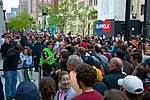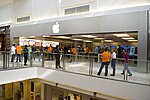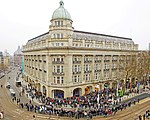Apple Store
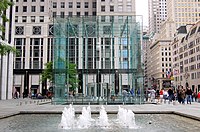 | |
| Company type | Retail Workshop One to One |
|---|---|
| Industry | Subsidiary of Apple Inc. Computer hardware Computer software Consumer electronics Distribution |
| Founded | May 19, 2001 |
Number of locations | World: 444 stores in 16 countries (263 US/181 elsewhere) United States: 263 United Kingdom: 38 Canada: 29 Australia: 21 France: 17 Italy: 15 Germany: 14 China: 12 Spain: 11 Japan: 8 Switzerland: 4 Hong Kong: 3 Sweden: 3 Netherlands: 3 Turkey: 2 Brazil: 1 |
Key people | Tim Cook (CEO) Angela Ahrendts (SVP: Retail and Online Stores) Phil Schiller (SVP: Worldwide Marketing) |
| Products | Macs, OS X, iPads iPhones, iPods, Apple TV, Apple & 3rd-party software and accessories |
| Website | www |
The Apple Store is a chain of retail stores owned and operated by Apple Inc., dealing with computers and consumer electronics. The stores sell Macintosh personal computers, software, iPods, iPads, iPhones, third-party accessories, and other consumer electronics such as Apple TV. All stores offer a Genius Bar for technical support and repairs, as well as free workshops available to the public, while some high-profile stores feature a theater for presentations and workshops and a studio for training with Apple products. Under the leadership of Ron Johnson, the former senior Vice President of Retail Operations, the Apple Stores have, according to an article in The New York Times, been responsible for "[turning] the boring computer sales floor into a sleek playroom filled with gadgets".[1]
With global sales of US$16 billion in merchandise in 2011, Apple leads the United States retail market in terms of sales per unit area.[2] As of October 2014[update], Apple has 444 retail stores in 16 countries and an online store available in 39 countries.[3]
Description
Many stores are located inside shopping malls, but Apple has built several stand-alone "flagship" stores in high-profile locations. Flagship stores have opened in Amsterdam, Barcelona, Berlin, Beijing, Bologna, Boston, Bordeaux, Brisbane, Chicago, Düsseldorf, Edinburgh, Frankfurt, Geneva, Glasgow, Haarlem, Hamburg, Hong Kong, Houston, Istanbul, London, Madrid, Montreal, Munich, New York, Osaka, Paris, Perth, Portland, San Francisco, Shanghai, Shenzhen, Strasbourg, Sydney, Tokyo, Toronto, Turin, Zürich and Rio de Janeiro.[citation needed]
Each store is designed to suit the needs of the location and regulatory authorities. Apple has received numerous architectural awards for its store designs, particularly its midtown Manhattan location on Fifth Avenue,[4][5] whose glass cube was designed by Bohlin Cywinski Jackson.[6]
Several flagship stores feature glass staircases,[7] which for multi-level stores was originally intended to attract customers to visit the upper floors, and some even feature a glass bridge. The New York Times wrote that these features were part of then-CEO Steve Jobs' extensive attention to detail. The first glass staircase received a design patent in 2002 from the US Patent and Trademark Office with Jobs' name first, followed by several others,[8][9] while the staircase design itself received a design patent, and the complex glass and hardware system received a separate technical patent.[10] Apple worked with architect Bohlin Cywinski Jackson and engineer Eckersley O'Callaghan Structural Design in designing the staircase.[11][12]
The Apple Store in Regent Street, London, was the first to open in Europe in November 2004, and is the most profitable shop in London with the highest sales per square foot, taking £60,000,000 pa, or £2,000 per square foot.[13] The Regent Street store was surpassed in size by the nearby Apple Store in Covent Garden, which was surpassed in size by the Grand Central Terminal Apple Store, New York City, in December 2011.
Ron Johnson, Senior Vice President of Retail Operations until November 1, 2011, was responsible for site selection, in-store service, and store layout, however he had had no control over the inventory in the stores. Instead, inventory is done company wide by then-COO and now CEO Tim Cook who has a background in supply chain management.[14][14]
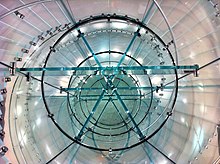

Of the 43,000 Apple employees in the United States 30,000 work at Apple Stores. Due to the popularity of the brand applicants for jobs at Apple Stores are numerous with many young workers applying; pay is modest but generous benefits are offered. The pace of work is high due to the popularity of the iPhone and iPad. Employees typically work for only a few years as career prospects are limited with no path of advancement other than limited retail management slots.[2] Apple Store employees make above average pay for retail employees and are offered money toward college as well as gym memberships, 401k plans, healthcare plans, product discounts, and reduced price on purchase of stock. The retention rate for the technicians who man the Genius Bar is over 90%.[15]
History
Third-party retail
Steve Jobs, the co-founder of Apple, returned as interim CEO in 1997. According to Jobs biographer Walter Isaacson, Jobs began a concerted campaign to help sales by improving the retail presentation of Macintosh computers. Even with new products launched under Job's watch like the iMac and the PowerBook G3 and an online store, Apple still relied heavily on big box computer and electronics stores for most of their sales. There, customers continued to deal with poorly trained and ill-maintained Mac sections that did not foster customer loyalty to Apple and did not help differentiate the Mac user-experience from Windows.[16][17][17] In fact, the retailer trend was towards selling their own generic in-house brand PCs which used even cheaper components than those by major PC makers, increasing retailer overall margins by keeping the manufacturing profits. This "provided a powerful profit motive to convert customers interested in buying a Mac into the owners of a new, cheaply assembled, house brand PC". [7]
Tim Cook, who joined Apple in 1998 as Senior Vice President for Worldwide Operations, announced the company would "cut some channel partners that may not be providing the buying experience [Apple expects]. We're not happy with everybody." Jobs severed Apple's ties of every big box retailer, including Sears, Best Buy, Circuit City, Computer City and Office Max to focus its retail efforts with CompUSA Between 1997 and 2000, the number of Mac authorized resellers dropped from 20,000 to just 11,000, with majority of these were cuts made by Apple itself. Jobs proclaimed that Apple would be targeting Dell, with Cook's mandate to match or exceed Dell's lean inventories and streamlined supply chain, "with our new products and our new store and our new build-to-order, we're coming after you, buddy." While Dell had operated as a direct mail order and online order company, having pulled out of retailers to realize greater profit margins and efficiency, Apple had direct orders with sales handled by its channel partners, other mail order resellers, independent dealerships, and the new relationship with CompUSA to build "stores within a store".[8]
Jobs did a study for stand alone "store within a store" for 34 sites in Japan. These sites were designed by Eight Inc. who was designing the Apple MacWorld and product launch events with Apple. CompUSA was one of the few retailers that kept its Apple contract by agreeing to adopt Apple's "store within a store" concept designed by Eight Inc. This required that approximately 15% of each CompUSA store would be set aside for Mac hardware and software (including non-Apple products) and would play host to a part-time Apple salesperson. However the "store within a store" approach did not meet expectations, in part because the Apple section was in the lowest-traffic area of CompUSA stores. CompUSA president Jim Halpin, who proclaimed that he would make Apple products his top priority, was forced to resign a year later. Also CompUSA had trouble finding well-trained staff, as most store clerks usually steered customers away from Macs and towards Windows PCs. Despite these setbacks, CompUSA sales of Macs had increased, thanks to the attractiveness of Apple display areas with their self-running demos, as well as the irresistible design of the new Macs, and perhaps due to grass-roots efforts of local user-group members who volunteered their time to help prospective customers. Apple then added Best Buy as a second authorized reseller.[18] Challenges still remained, as resellers' profit margins on selling Macs was only around 9%, and selling Macs was only worthwhile if ongoing service and support contracts were provided, of which retailer experiences were inconsistent [19]
Origins
This section needs additional citations for verification. (September 2014) |
Jobs believed the Apple retail program needed to fundamentally change the relationship to the customer, and provide more control over the presentation of Apple products and the Apple brand message. Jobs recognized the limitations of third-party retailing and began investigating options to change the model.[16][17][20] In 1999 Jobs retained Eight Inc. as the strategic retail design partner to begin creating the Apple retail store, and began the search for senior retail and development executives. Tim Kobe of Eight Inc. prepared an "Apple Retail" white paper for Jobs, outlining the ability of separate Apple retail stores to directly drive the Apple brand experience—Kobe used their recently completed work with The North Face and Nike as a basis for the white paper.[citation needed]
In 1999, Jobs personally recruited Millard Drexler to serve on Apple's board of directors, Drexler was the CEO of Gap Inc., which experienced explosive growth that was attributed to retailing environments and marketing, rather than the brand's products or competitive prices. Drexler was one of the few directors who supported Jobs' retail stores initiative—the others on the board were skeptical, as the initiative would compete with third-party retailers and Gateway, Inc. had struggled with its own stores. In 2000, Jobs hired Johnson from Target, where, as the vice president of merchandising, he was responsible for launching the Michael Graves line of consumer products[2] that raised Target's image. At Drexler's suggestion, the retail and development teams headed by Allen Moyer, from The Walt Disney Company, then began a series of mock-ups for the Apple store inside a warehouse near the company's Cupertino headquarters.[citation needed]
On May 15, 2001, Jobs hosted a press event at Apple's first store at the Tysons Corner Center mall—an upscale mall located in Fairfax County, then the richest county in the U.S.—in Tysons Corner, Virginia.[21] The first two Apple Stores opened on May 19: the first opening was the Tysons Corner location, and the Glendale, California store, at the Glendale Galleria, opened later in the day due to the time zone difference. More than 7,700 people visited Apple’s first two stores in the opening weekend, spending a total of US$599,000.[22]
Expansion
Several publications and analysts predicted the failure of Apple Stores, based on sales made per square foot which was a standard metric in computer retail at the time. It was thought that because of the stores' diminutive size and non-aggressive sales team, Apple would succeed in presenting the Mac but fail in making a significant number of sales, despite the huge turnout for the Virginia store (7,700 in the first day purchases). The Apple retail program established its merits and the momentum provided by the introduction of the iPod drove enormous interest in the Apple brand. The "high-profile" retail stores began the initiation of the Flagship style component of the Apple retail strategy. The first high-profile store was in Soho in New York City and was launched to great success; store sales were double projections the first year. The high-profile retail stores, developed by Steve Jobs, the Apple retail team, designers Eight Inc., architects Bohlin Cywinski Jackson and structural engineers Eckerlsey O'Callaghan have become among the most recognized brand expressions in retail. Apple had proved its critics wrong and by 2007 it ranked among the top retailers in the world. Apple opened its 200th store on October 26, 2007, in Gilbert, Arizona, 2,251 days after opening its Tysons Corner store.[23]
According to Fortune; "Saks, whose flagship store is down the street, generates sales of $362 per square foot a year. Best Buy stores turn $930 - tops for electronics retailers - while Tiffany & Co. takes in $2,666. Audrey Hepburn liked Tiffany's for breakfast, but at $4,032 per square foot, Apple is eating everyone's lunch".[16] In 2011 Apple Stores in the United States had revenue of $473,000 for each employee.[2] According to the research firm RetailSails, the Apple Store chain ranks first among U.S. retailers in terms of sales per unit area in 2011, with sales of US$3,085 per square feet, almost doubling Tiffany & Co., the second retailer on the list.[2]
Apple has since re-established ties with major big box retailers like Best Buy and Staples Inc.,[24] as these chains have considerably more geographical reach than the existing network of Apple Stores. Authorized Apple resellers have a dedicated store-within-a-store with wood tables and a backlit Apple Logo. These in-store kiosks feature at least a full-sized Apple ad, and some of the larger displays feature a LCD screen run by a Mac Mini. These boutiques presently showcase iPad tablets and Mac computers, while iPods have their own dedicated space in the MP3 player aisle, and iPhones are displayed in the mobile phone section alongside their wireless carrier.[25] The relationship with Best Buy calls for the company to send Apple Solutions Consultants (ASCs) to train Best Buy employees to be familiar with Apple's product lineup.[17][26] Apple resellers often have special sales promotions not featured in Apple Stores, but they do not provide support for AppleCare.
Apple is reported to be working with Walt Disney World to create the world's largest Apple Store as part of the large scale development of their Downtown Disney retail, dining and entertainment area that will eventually be completed in 2016 under the name of Disney Springs.[27]
Changes
Originally, Apple Stores contained a dedicated point-of-sale (POS) station. However, in 2006, Apple began introducing a new store layout and design with surgical-grade stainless steel walls and backlit signage. The new store design replaced the dedicated point-of-sale station with the handheld EasyPay system. A dedicated point-of-sale station still exists in most of these stores to facilitate transactions not paid for by credit card.[28][29] The Regent Street store has more point-of-sale terminals than any other store. Only flagship stores and a few older locations have a dedicated point of sale; all other stores have a POS behind the Genius Bar. Apple has recently changed their EasyPay systems to operate on iPhone 5s, instead of the previous iPod Touch and earlier Windows-based systems. The previous iPod EasyPays featured a custom housing and the Infinite Peripherals Linēa-Pro barcode scanner and card reader, to allow all transactions to be completed on the iPod. Current iPhone 5s systems use a custom housing by VeriFone which allows barcode and QR code scanning, credit card swiping, EMV chip compatibility, NFC compatibility, debit PIN entry, and onboard CVV verification.[30]
On May 22, 2011, Apple replaced their acrylic displays that had information about the product with interactive iPad 2 displays, called Smart Signs, which add more information about the product like specifications, comparisons and extended warranties.[31] This transition from paper to touch displays was dubbed "Apple Store 2.0" by online blogs such as Engadget and Gizmodo.[32]
Influence
Apple Stores have considerably changed the landscape for consumer electronics retailers and influenced other technological companies to follow suit. According to The Globe and Mail, "Apple’s retail stores have taken traffic, control and profits away from Verizon as well as electronics retailers, such as Best Buy, that once looked at wireless phones as a lucrative profit source". CNET has reported that the "Apple retail experience hurts Best Buy" and noted "Buy a MacBook at the Apple Store and it's hard to go back to the Best Buy Windows laptop buying experience". Due to Apple salespeople being more knowledgeable, and Apple stores being more appealing, aesthetically and practically (looks, layout), CNET suggested that customers would prefer in-store purchases of Apple products at Apple Stores rather than authorized resellers such as Best Buy.[33]
The successful experience that Apple had with its retail stores has been applied to Disney Stores, since Jobs was elected to that company's board of directors in 2006.[34]
Genius Bar

All Apple Stores feature a Genius Bar, where customers can receive technical advice or set up service and repair for their products. The Genius Bar provides software support for Mac OS X and hardware service on products that are not classified vintage or obsolete.[35] However, in most cases the Geniuses will at least attempt to assist customers with older hardware.[36] Originally, visitors to the Genius Bar were offered free Evian water. Apple dropped this amenity in February 2002.[citation needed]
To address increasing numbers of iPod customers at the Genius Bar, some new stores also feature an iPod Bar. First seen at the Ginza store in Tokyo, then at the New York City locations, the iPod Bar has become a common feature at newly built stores.[37]
Many new stores feature a station called The Studio, a Genius Bar-like setting where customers can meet with a "Creative" and receive help with projects ranging from organizing a photo album to music composition to film editing.[citation needed] Some of the older stores are being considered to carry a Studio in a future remodel, in some cases replacing the older theaters.[citation needed]
Genius Training Manual
Every Apple Store employee is provided with a training manual that teaches him or her marketing and selling techniques. The basic tenet is that "Everyone in the Apple Store is in the business of selling".[38]
Store openings
Store openings have become special events among avid Macintosh users.[citation needed] Opening day attracts thousands of customers who line up early in the morning or even the night before.[citation needed] Most openings are accompanied by giveaways of prizes such as T-shirts and "lucky bags" at flagship store openings.[39][40]
-
Tysons Corner Center, Virginia, US on May 19, 2001; a line at the opening of the first Apple Store
-
The sidewalk of Boylston Street, Boston, US on May 15, 2008; a massive crowd gather at the opening of the new store
-
At the Boylston Street Apple Store opening day, a man holds-up his commemorative T-shirt given out
-
Regent Street, London, England, UK; at its opening at 10am November 20, 2004 it was the largest worldwide
-
Bath, England, UK
-
Covent Garden, London, England, UK; as with Regents Street branch, one of the largest Stores worldwide
-
Relocated Store, Yorkdale Shopping Centre, Toronto, Ontario, Canada; the original was the first in Canada
Locations
The first two Apple Stores opened in the United States in 2001 (see history above). In 2003, Apple expanded its operations into Japan, opening the first store outside of the United States. This was followed by the opening of stores in the United Kingdom, Canada, Italy, Australia, China, Switzerland, Germany, France, Spain, Hong Kong (China), Netherlands, Sweden, Brazil, and Turkey. In 2010 a major effort to expand sales in China was announced along with opening of a store in Shanghai. The first Apple Store in Hong Kong, being the 100th overseas store outside the United States opened on September 24, 2011, occupying Podium 1 and 2 of IFC Mall.
| Location | First openings | Open stores | Reference |
|---|---|---|---|
| May 19, 2001 | 263 | [41] | |
| November 20, 2004 | 38 | [42] | |
| May 21, 2005 | 29 | [43][44] | |
| June 19, 2008 | 21 | [45] | |
| November 7, 2009 | 17 | [46] | |
| March 31, 2007 | 15 | [47] | |
| December 6, 2008 | 14 | [48] | |
| July 19, 2008 | 12 | [49] | |
| September 4, 2010 | 11 | [50] | |
| November 30, 2003 | 8 | [51] | |
| September 25, 2008 | 4 | [52][53] | |
| September 24, 2011 | 3 | [54] | |
| March 3, 2012 | 3 | [55] | |
| September 15, 2012 | 3 | [56] | |
| April 5, 2014 | 2 | [57] | |
| February 15, 2014 | 1 | [58] |
Apple Company Store
The Apple Company Store is found on the Apple Campus in One Infinite Loop. This store is the original Apple Employee store, and is open to the public. The store does not sell any of Apple's computer or iPhone lineups, and it does not provide on-site support or repairs. However, it does offer many iPod, iPad, and accessory products for sale. It is also the only place in the world where Apple logo T-shirts, hats, and other such merchandise can be purchased.[59] Most Apple products are on display here, and various software and accessories can be purchased as well.[60]
Imitations

In July 2011, an American expatriate blogger who lives in the southwestern Chinese city of Kunming reported on her discovery of what she called "the best ripoff store we had ever seen"—a fake Apple Store, complete with the glass exterior, wood display tables, winding staircase and large promotional posters found in legitimate Apple Stores, and with employees wearing lanyards and the same T-shirts as actual Apple Store employees.[61] The Wall Street Journal reported that the store had "gotten widespread international attention for the remarkable lengths to which its proprietors seem to have gone to mimic the look and feel of a real Apple Store."[62] The fake Apple Store was mentioned by U.S. presidential contender Mitt Romney in the second 2012 election debate.[63] Chinese law prohibits retailers from copying the look and feel of competitors' stores, but enforcement is lax.[64]
According to The Wall Street Journal, unauthorized Apple resellers are found throughout China; the blogger's original post noted that two such stores were located within walking distance of the first knockoff, one of them with a misspelled sign reading "Apple Stoer".[62] An employee of the first knockoff confirmed that the store was not one of the 13[64] authorized Apple resellers in Kunming.[61][62] In a follow-up report, Reuters indicated that local authorities in Kunming had closed two fake Apple stores in that city due to lack of official business permits, but allowed three other such stores to stay open, including the one that had attracted international attention.[64] The operators of that store had applied for a reseller license from Apple.[64] At the time of the report, only four legitimate Apple Stores had opened in China, with two in Beijing and two in Shanghai.[62]
Following these events, more real Apple Stores in China began opening, an early one being the Shenzhen Apple Store on November 3, 2012.[65]
See also
References
- ^ Clifford, Stephanie; Helft, Miguel (June 14, 2011). "Ron Johnson, Apple Stores Chief, to Lead J.C. Penney". The New York Times.
- ^ a b c d e David Segal (June 23, 2012). "Apple's Retail Army, Long on Loyalty but Short on Pay". The New York Times. Retrieved June 23, 2012.
- ^ "The Apple Store – International". Apple Inc. Retrieved June 9, 2014.
- ^ Lohr, Steve (2006-05-19). "Apple, a Success at Stores, Bets Big on Fifth Avenue". The New York Times. Retrieved 2006-05-19.
- ^ "Apple Computer Retail Stores: Gold, Environments". Industrial Designers Society of America. 2002. Archived from the original on 2006-02-14. Retrieved 2006-05-12.
- ^ Saffron, Inga (2011-03-06). "Bernard Cywinski, paterfamilias of Philadelphia architecture". The Philadelphia Inquirer. Retrieved 2011-04-02.[verification needed]
- ^ "ifo AppleStore - List of Glass Staircase Stores".
- ^ Helft, Miguel; Carter, Shan (August 25, 2011). "Apple Patents Show Steve Jobs's Attention to Design". The New York Times.
- ^ Carter, Shan (August 25, 2011). "Steve Jobs's Patents". The New York Times.
- ^ "Staircase Page Patent C" (pdf).
- ^ "ifo Apple Store - Glass Staircase".
- ^ "Eckersley O'Callaghan".
- ^ "Apple Store London". Macdailynews. 2010. Retrieved 2010-08-06.
- ^ a b Adam Lashinsky (August 25, 2011). "How Apple works: Inside the world's biggest startup". CNN.
- ^ "New York Times profiles Apple's retail operations and employees". 9 to 6 Mac. June 23, 2012. Retrieved June 24, 2012.
- ^ a b c The Roots of Apple's Retail Stores
- ^ a b c d Best Buy and Apple Together Again - AppleMatters
- ^ [1]
- ^ [2]
- ^ [3]
- ^ Keith Wagstaff (10 November 2011). "Check Out Every Apple Store Ever Opened, in Order". TIME Techland. TIME Inc. Retrieved 14 September 2014.
- ^ Benj Edwards (19 May 2011). "A tale of two Apple Stores (the first two)". MacWorld. IDG Consumer & SMB. Retrieved 14 September 2014.
- ^ Apple nearing milestone opening
- ^ [4]
- ^ [5]
- ^ Apple throwing its weight into Best Buy Mac sales? | Ars Technica
- ^ totalorlando.com blog, Downtown Disney Apple Store Coming Your Way!
- ^ "Store Redesign Photos". ifo Apple Store. 2006-09-22. Retrieved 2006-10-04.[dead link]
- ^ "Apple Store's Easy Pay". Adding Understanding blog. 2006. Retrieved 2006-10-04.
- ^ http://9to5mac.com/2014/05/09/apple-store-employees-switching-from-ipod-touch-to-iphone-5s-for-easypay-pos-system/
- ^ First look at 'Apple Store 2.0' in Australia[dead link]
- ^ Apple Store celebrates 10th anniversary with 2.0 experience, iPads locked in Lucite (video) - Engadget
- ^ [6]
- ^ NYT: Apple inspiring new Disney retail strategy Macworld
- ^ "Vintage and obsolete products"
- ^ "Old School Genius". Tech Today. 2005. Archived from the original on 2006-10-15. Retrieved 2006-10-04.
- ^ "iPod Bar Japan: Great Service But The Cocktails Need Work". Gizmodo. 2005. Archived from the original on 12 September 2006. Retrieved 2006-10-04.
{{cite web}}: Unknown parameter|deadurl=ignored (|url-status=suggested) (help) - ^ Biddle, Sam. "How To Be a Genius: This Is Apple's Secret Employee Training Manual". Gizmodo.com. Retrieved 31 August 2012.
- ^ "Grand Opening Lucky Bags". ifo Apple Store. November 28, 2005. Archived from the original on April 27, 2006. Retrieved 2006-05-12.
{{cite web}}: Unknown parameter|deadurl=ignored (|url-status=suggested) (help) - ^ Preview: Inside Shanghai's first Apple Store - Shanghaiist
- ^ Apple Retail Store (United States) - Store List
- ^ Apple Retail Store (United Kingdom) - Store List
- ^ Apple Retail Store (Canada) - Store List
- ^ Apple Store (Canada) - Liste des boutiques Template:Fr icon
- ^ Apple Retail Store (Australia) - Store List
- ^ Apple Store (France) - Liste des magasins Template:Fr icon
- ^ Apple Store (Italia) - Elenco negozi Template:It icon
- ^ Apple Retail Store (Deutschland) - Liste der Stores Template:De icon
- ^ Apple Store 零售店 - 零售店列表 Template:Zh icon
- ^ Apple Store (España) - Lista de tiendas Template:Es icon
- ^ アップル - Apple Store - ストア一覧 Template:Ja icon
- ^ Apple Store (Schweiz) - Liste der Stores Template:De icon
- ^ Apple Store (Suisse) - Liste des magasins Template:Fr icon
- ^ Apple Store (Hong Kong) - 店舖列表 Template:Zh icon
- ^ Apple Store (Nederland) - Lijst van Stores Template:Nl icon
- ^ Apple Store (Svergie) - Lista över butiker Template:Sv icon
- ^ Apple Store - Mağaza Listesi Template:Tr icon
- ^ Apple Store - Lista de Iojas Template:Pt icon
- ^ Apple - The Company Store
- ^ Apple Company Store - Cupertino, CA
- ^ a b Chao, Loretta (July 21, 2011). "The Ultimate Knock-Off: A Fake Apple Store". The Wall Street Journal. Retrieved July 22, 2011.
- ^ a b c d Chao, Loretta; Feng, Sue (July 21, 2011). "Fake Apple Store Clerk Speaks out". The Wall Street Journal. Retrieved July 22, 2011.
- ^ Mozur, Paul (17 October 2012). "Mitt Romney Called Out on Fake Apple Store". Wall Street Journal. Retrieved 8 April 2014.
"There's even an Apple store in China that's a counterfeit Apple store, selling counterfeit goods," Mr. Romney said in response to a question about the outsourcing of American jobs, according to the transcript debate.
- ^ a b c d Lee, Melanie (July 25, 2011). "Chinese city orders two fake Apple Stores to close". Reuters. Archived from the original on July 26, 2011. Retrieved July 26, 2011.
{{cite news}}: Unknown parameter|deadurl=ignored (|url-status=suggested) (help) - ^ "Apple Store in Shenzhen (Grand Opening)". YouTube. November 5, 2012. Retrieved November 1, 2013.
External links
- Apple (United States) - Apple Retail Stores – list of all worldwide stores
- IFO Apple Store – news and information about store openings
- Bohlin Cywinski Jackson – architectural photos of many Apple Stores


